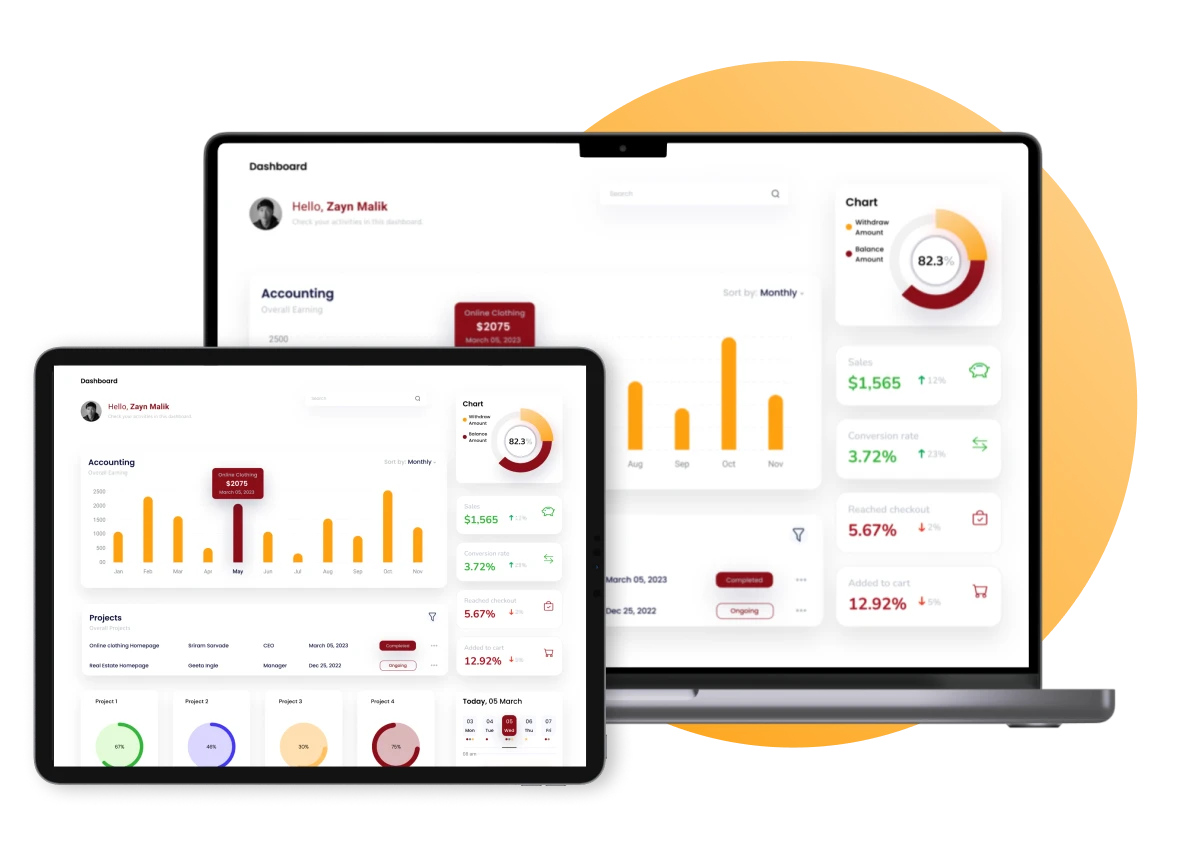Imagine pouring your hard-earned money into a business, only to wonder if it’s truly paying off. Pamilyar, ‘di ba?
Every peso you invest has the potential to bring in returns, but how do you know if it’s working for you? For businesses, it’s all about making a profit—not just covering costs but actually growing. And that’s where Return on Investment (ROI) comes in.
ROI isn’t just a number; it’s a measure of whether each peso spent brings back more to your pocket. If you’re serious about maximizing profit and making every investment count, understanding ROI isn’t optional. It’s the key to smarter, more profitable decisions.
Don’t miss out! Dive into this guide to learn how understanding ROI can be a game-changer for your business success.
Key Takeaways
|
Table of Contents
What is Return on Investment (ROI)?

Return on Investment, or ROI, is a simple way to determine how much profit you’re making from an investment compared to its cost. Accounting software can make this easier, acting as a financial scorecard that shows whether your spending is paying off.
For example, if you invest in marketing, improving operations, or developing a new product, ROI helps you see if these expenses are truly bringing in more than they cost. So, how does ROI work? It’s measured as a percentage, which makes it easy to understand.
Here’s the basic formula:
ROI = (Net Profit / Cost of Investment) x 100
If the result is positive, your investment is making money. If it’s negative, it’s a loss. This clear number helps business owners decide if they should keep investing in something or make changes to boost profits.
The Difference Between Revenue, Turnover, and Profit
It’s crucial to distinguish between revenue, turnover, and profit as they each play distinct roles in evaluating business performance:
| Type | Difference |
|---|---|
| Revenue | The total income generated from all sales. It shows the gross amount earned before any expenses are considered. |
| Turnover | The flow of money made from business operations over a certain period. It indicates how efficiently the business generates income but doesn’t account for costs. |
| Profit | The amount left after subtracting all expenses, including production and salaries. It represents the actual earnings and is often called “net profit.” |
Many people confuse turnover with profit. However, turnover is a measure of gross income, while profit reflects net earnings after expenses.
Why is ROI Important for Your Business?
Understanding and calculating Return on Investment (ROI) is essential for businesses seeking to make informed financial choices and boost profitability. Here are some key reasons why ROI is so valuable:
- Guiding Investment Decisions: ROI shows which investments bring the most value, helping business owners prioritize high-return initiatives and spend funds wisely.
- Measuring Marketing Effectiveness: ROI helps evaluate the success of marketing efforts, revealing which campaigns deliver the best results and allowing for smarter, more focused strategies.
- Enhancing Operational Efficiency: By focusing on high-ROI activities, companies can streamline operations, reduce unnecessary spending, and improve overall productivity.
- Increasing Business Profitability: ROI analysis directs focus to profit-driving areas, helping businesses cut waste and achieve greater financial success.
In summary, calculating ROI provides businesses with a clear understanding of which efforts yield the most profit, ensuring resources are allocated wisely. By focusing on high-ROI activities, companies can enhance their financial stability and achieve sustained growth.

How to Improve Your Return on Investment

For Filipino businesses aiming to boost their Return on Investment (ROI), there are several effective strategies that can make a significant difference. Here’s how you can maximize every peso invested to grow your business sustainably:
1. Effective marketing campaigns
Effective marketing is a key driver of ROI. By focusing on promotions that target the right audience, businesses can increase visibility and sales.
Strategic marketing not only attracts new customers but also maximizes the impact of each marketing dollar spent, creating a more efficient use of resources that directly benefits ROI.
2. Enhancing product quality
Quality is crucial in attracting and retaining customers. High-quality products often command higher prices, increasing revenue. Moreover, investing in quality builds trust and loyalty among customers, leading to repeat purchases.
This loyalty is invaluable for long-term ROI, as customers who trust your brand are likely to return, helping boost overall profitability.
3. Providing outstanding customer service
Exceptional customer service is a powerful asset in improving ROI. Satisfied customers are more likely to return and recommend your business to others.
By offering responsive and helpful service, businesses can increase customer satisfaction, which leads to sustained sales. Repeat business and word-of-mouth referrals are cost-effective ways to boost ROI.
Practical Example of Calculating ROI
Let’s take an example:
A Filipino shoe business, “Zapatos,” produces 500 pairs of shoes, each priced at ₱200. The production costs amount to ₱57,000. After selling all 500 pairs, Zapatos generates ₱100,000 in revenue. The profit, after deducting expenses, is ₱43,000.
To calculate ROI:
- Number of Shoes Produced = 500
- Price per Shoe = ₱200
- Production Costs (Cost of Investment) = ₱57,000
- Total Revenue = Number of Shoes Produced x Price per Shoe = 500 x ₱200 = ₱100,000
- Net Profit = Total Revenue – Production Costs = ₱100,000 – ₱57,000 = ₱43,000

Substitute values:

This 75% ROI shows that for every peso invested, the company gains ₱0.75 in profit.
Benefits of Tracking ROI in Business
Tracking ROI offers critical insights for businesses of any size. Here’s how it adds value:
- Improve Financial Planning: ROI highlights areas with the best returns, helping businesses allocate resources more effectively and make smarter investments.
- Prioritize High-Return Activities: By identifying activities that yield the most profit, companies can focus on what truly drives growth.
- Enhance Budget Efficiency: ROI tracking allows businesses to allocate budgets wisely, ensuring funds are directed to impactful initiatives.
- Evaluate Marketing Success: Assessing ROI on marketing efforts reveals which campaigns are most effective, guiding better marketing strategies.
- Enable Strategic Adjustments: Regular ROI analysis helps businesses monitor and adjust strategies, staying competitive and financially resilient.
In short, tracking ROI empowers businesses to make informed, data-driven decisions, ensuring sustainable growth and profitability.
Automate Return on Investment Calculation with HashMicro’s Accounting Software

Calculating ROI manually can be a time-consuming and error-prone task, especially when managing multiple investments, expenses, and revenue streams. HashMicro’s Accounting Software simplifies the process by automating these calculations, giving you instant, accurate insights into your business’s financial health.
By removing the guesswork, you can make smart, data-driven decisions with confidence. Here’s how HashMicro’s Accounting Software can truly benefit your business:
- Save Time and Reduce Manual Work: Say goodbye to complex spreadsheets and manual calculations. HashMicro’s software automates the process, letting you focus on what matters—growing your business.
- Get Instant Financial Insights: This software provides real-time data on profits, expenses, and investments so you can quickly see which areas deliver the best returns.
- Make Smarter Financial Decisions: By tracking ROI automatically, HashMicro helps you make informed choices on where to allocate funds, ensuring your resources are used effectively.
- Optimize Budget Allocation: With clear ROI data at your fingertips, you can easily spot which activities are worth investing in and which aren’t, optimizing your budget for maximum impact.
- Boost Profitability with Accurate ROI Tracking: The software’s precise calculations help you zero in on high-return activities, boosting overall profitability and keeping your business on a growth path.
Having a tool that simplifies financial decisions is invaluable. Using an accounting system gives you a competitive edge by making ROI tracking fast, easy, and precise. Whether you’re a startup or an established enterprise, HashMicro empowers you to understand your financial landscape and invest confidently.
Conclusion
Knowing about ROI is crucial for any business aiming for long-term growth and success. By focusing on profitable investments and product quality, Filipino entrepreneurs can make smarter financial choices, boost profitability, and improve their return on equity. ROI provides a clear view of what drives success, helping you maximize every peso while ensuring sustainable financial growth and a strong return on equity.
HashMicro’s Accounting Software simplifies ROI tracking, making financial management easy and accurate. With automated calculations, real-time insights, and smart budgeting, you can focus on growing your business. Try HashMicro’s free demo today to see the difference it can make!

FAQ Around Return on Investment
-
What is ROI and why is it important?
ROI, or Return on Investment, measures the profitability of an investment compared to its cost. It’s essential for tracking financial success and making smart, profit-focused decisions.
-
What is the meaning of ROI?
ROI stands for Return on Investment, a key metric that shows how much profit an investment brings relative to its cost. It helps businesses understand the value of their spending.
-
Why is it important to calculate the return on investment?
Calculating ROI reveals which investments yield the most profit, guiding smarter financial choices. It allows businesses to focus on activities that drive growth and profitability.




































